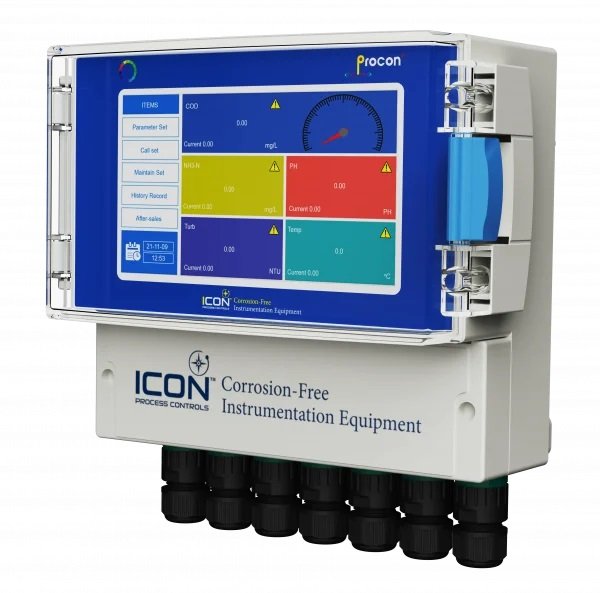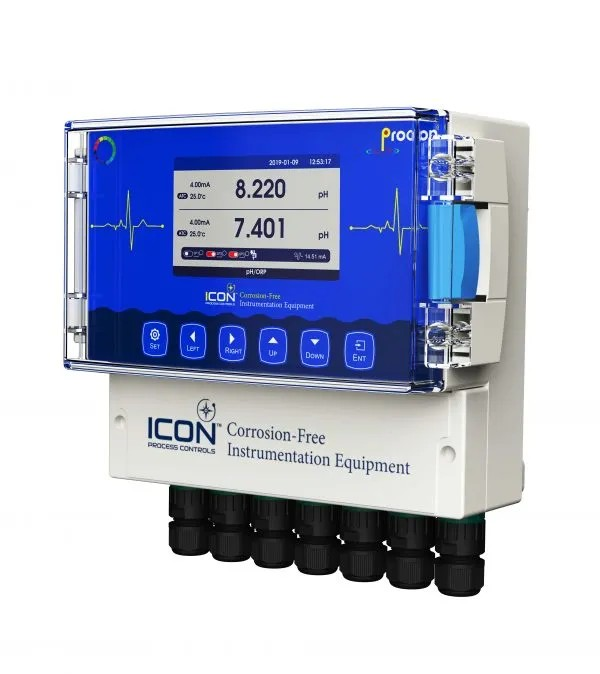6313 pH or mV Controller/Transmitter
Brand: JENCO - pH Transmitter/Controller, Programmable, LCD Display
Features
Clear LCD displays pH or mV, with temperature and relay status simultaneously.
Automatic buffer recognition of US and NIST buffer sets. Calibration data is stored in memory and is ready for use on power-up.
Displays absolute and relative ORP.
Isolated and reversible 4-20 mA current output for pH or ORP allows it to be used as a proportional output.
2 programmable on/off relays: 2 for pH or ORP.
CE Approved
Password protection.
IP65
Brand: JENCO - pH Transmitter/Controller, Programmable, LCD Display
Features
Clear LCD displays pH or mV, with temperature and relay status simultaneously.
Automatic buffer recognition of US and NIST buffer sets. Calibration data is stored in memory and is ready for use on power-up.
Displays absolute and relative ORP.
Isolated and reversible 4-20 mA current output for pH or ORP allows it to be used as a proportional output.
2 programmable on/off relays: 2 for pH or ORP.
CE Approved
Password protection.
IP65
Brand: JENCO - pH Transmitter/Controller, Programmable, LCD Display
Features
Clear LCD displays pH or mV, with temperature and relay status simultaneously.
Automatic buffer recognition of US and NIST buffer sets. Calibration data is stored in memory and is ready for use on power-up.
Displays absolute and relative ORP.
Isolated and reversible 4-20 mA current output for pH or ORP allows it to be used as a proportional output.
2 programmable on/off relays: 2 for pH or ORP.
CE Approved
Password protection.
IP65
-
pH Range: -2.00 to 16.00 pH
pH Resolution: 0.01 pH
pH Accuracy: ±0.1% of reading ± 1 digits
mV (RmV) Range: -2500 to 2500 mV (-6499 to 6499 mV)
mV (RmV) Resolution: 1 mV
mV (RmV)
Accuracy: ±0.1% of reading ± 1 digits
Temperature Range: -10.0 to 120.0 °C
Temperature Resolution: 0.1 °C
Temperature Accuracy: ±0.1 °C ± 1 digit
pH Buffer Recognition: US (1.68, 4.01 ,7.00 ,10.01, 12.46) or NIST (1.68, 4.00,6,86,9.18, 12.46), user selectable
pH Electrode Offset Recognition: ±100 mV at 7.00 pH /-91.7 mV to 108,3 mV at 6.86 pH
pH Electrode Slope Recognition: ±30% at 1.68, 4,00 , 4,01 ,9.18, 10.01 or 12.46 pH
Temperature Compensation: Auto -10.0 to 120.0 °C (Thermistor , 10K ohm /Resisotr,Balco 3K ohm at /RTD, PT-1000 )
Input Impedance: >1013 ohms
Input Select: User selectable pH or ORP
Current Output Range: 4 to 20 mA (isolated), programmable span
Current Output Scale: User programmable ,linear
Maximum Load: 500 ohm
Isolation Voltage: 500 V DC
Control Type: 2 On/Off controls for the pH or mV (RmV)
Relay Output: 5 A at 115 V AC or 2.5 A at 220 V AC, resistive load only
Security: 4-dight password
Power: 115 V AC or 230 V AC at 50/60 Hz
Ambient Temperature Range: 0 to 50 °C
Weight: 940 grams
Housing: IP 65 ,1/4 DIN case, 148mm depth
pH and ORP Electrodes
IP-600-10 ELECTRODES
Industrial pH Electrode (Flat Tip) PPS housing with 3/4” threads front and rear and BNC connector, includes 5 m cable.
pH Range—0 to 14 pH
Operating Temperature 0 to 80 °C
Pressure Tolerance Range 1: 75C/170F = 100 psig
Pressure Tolerance Range 2: 81C/180F = 85 psig
Pressure Tolerance Range 3: 100C/212F =50 psig
Reference Type: Ag/AgCl, double Junction
Thread: 3/4″NPT
Connect Material——Sensor Material
PPS————————-Glass
Connector: BNC or other
Cable length: Call for additional info.
IR-500-8 ORP ELECTRODE
ORP Range: -2000 to 2000 mV
Operating Temperature: 0 to 80 °C
Pressure tolerance: 100 psig (at 25 °C)
Reference Type: AgCl, double Junction
Thread: 3/4″NPT
Sensor Material: Pt
Connector: BNC or other
Cable Length: 5 m or other
What is pH?
Acidic and alkaine/Basic are two extremes that describe substances, usually liquids or chemicals, just like hot and cold are two extremes that describe temperature. A substance that is neither acidic nor alkaline is neutral.
The pH scale measures how acidic or alkaline a substance is. The scale ranges from 0 to 14. A pH of 7 is neutral. A pH less than 7 is acidic, and a pH greater than 7 is basic. Pure water is neutral, with a pH of 7.0. When chemicals are mixed with water, the mixture can become some level of either acidic or alkaline. Vinegar and lemon juice are acidic substances, while laundry detergents and ammonia are alkaline.
What is ORP?
Oxidation reduction potential (ORP) is an important method for testing water quality. Oxidation occurs when a substance lacking electrons — known as an oxidizing agent — looks for electrons from other substances. On the other hand, substances that have extra electrons to donate are known as reducing agents.
ORP classifies substances as oxidizing or reducing agents and is measured in millivolts (mV) by an ORP meter. A high ORP reading indicates the presence of an oxidizing agent. A low reading indicates a reducing agent. Water pollution levels tend to increase with low ORP readings and decrease with high readings. Scientists consider the ORP of water as an important indicator of pollution levels. Safe drinking water, for example, is an oxidizing agent with an ORP range between +200 and +600 mV. Chlorinated pool water, on the other hand, should have a much higher ORP between +650 and +750 mV.











